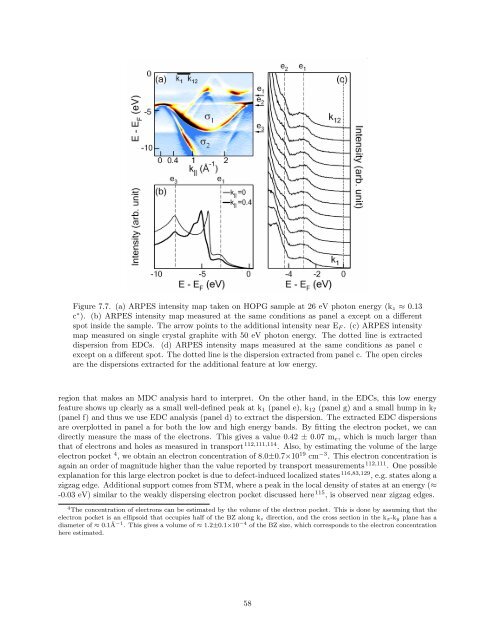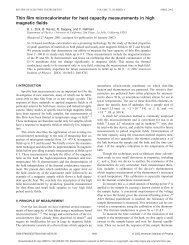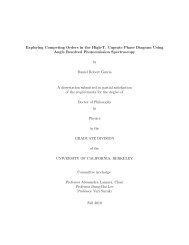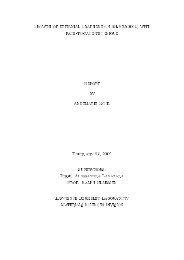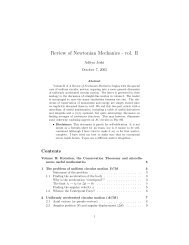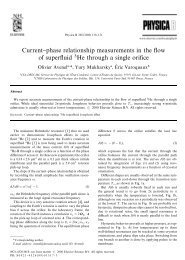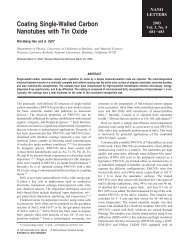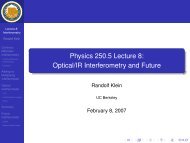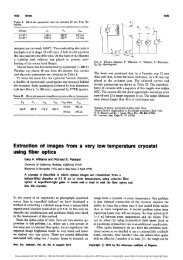Dirac Fermions in Graphene and Graphiteâa view from angle ...
Dirac Fermions in Graphene and Graphiteâa view from angle ...
Dirac Fermions in Graphene and Graphiteâa view from angle ...
You also want an ePaper? Increase the reach of your titles
YUMPU automatically turns print PDFs into web optimized ePapers that Google loves.
Figure 7.7. (a) ARPES <strong>in</strong>tensity map taken on HOPG sample at 26 eV photon energy (k z ≈ 0.13<br />
c ∗ ). (b) ARPES <strong>in</strong>tensity map measured at the same conditions as panel a except on a different<br />
spot <strong>in</strong>side the sample. The arrow po<strong>in</strong>ts to the additional <strong>in</strong>tensity near E F . (c) ARPES <strong>in</strong>tensity<br />
map measured on s<strong>in</strong>gle crystal graphite with 50 eV photon energy. The dotted l<strong>in</strong>e is extracted<br />
dispersion <strong>from</strong> EDCs. (d) ARPES <strong>in</strong>tensity maps measured at the same conditions as panel c<br />
except on a different spot. The dotted l<strong>in</strong>e is the dispersion extracted <strong>from</strong> panel c. The open circles<br />
are the dispersions extracted for the additional feature at low energy.<br />
region that makes an MDC analysis hard to <strong>in</strong>terpret. On the other h<strong>and</strong>, <strong>in</strong> the EDCs, this low energy<br />
feature shows up clearly as a small well-def<strong>in</strong>ed peak at k 1 (panel e), k 12 (panel g) <strong>and</strong> a small hump <strong>in</strong> k 7<br />
(panel f) <strong>and</strong> thus we use EDC analysis (panel d) to extract the dispersion. The extracted EDC dispersions<br />
are overplotted <strong>in</strong> panel a for both the low <strong>and</strong> high energy b<strong>and</strong>s. By fitt<strong>in</strong>g the electron pocket, we can<br />
directly measure the mass of the electrons. This gives a value 0.42 ± 0.07 m e , which is much larger than<br />
that of electrons <strong>and</strong> holes as measured <strong>in</strong> transport 112,111,114 . Also, by estimat<strong>in</strong>g the volume of the large<br />
electron pocket 4 , we obta<strong>in</strong> an electron concentration of 8.0±0.7×10 19 cm −3 . This electron concentration is<br />
aga<strong>in</strong> an order of magnitude higher than the value reported by transport measurements 112,111 . One possible<br />
explanation for this large electron pocket is due to defect-<strong>in</strong>duced localized states 116,83,129 , e.g. states along a<br />
zigzag edge. Additional support comes <strong>from</strong> STM, where a peak <strong>in</strong> the local density of states at an energy (≈<br />
-0.03 eV) similar to the weakly dispers<strong>in</strong>g electron pocket discussed here 115 , is observed near zigzag edges.<br />
4 The concentration of electrons can be estimated by the volume of the electron pocket. This is done by assum<strong>in</strong>g that the<br />
electron pocket is an ellipsoid that occupies half of the BZ along k z direction, <strong>and</strong> the cross section <strong>in</strong> the k x-k y plane has a<br />
diameter of ≈ 0.1Å −1 . This gives a volume of ≈ 1.2±0.1×10 −4 of the BZ size, which corresponds to the electron concentration<br />
here estimated.<br />
58


